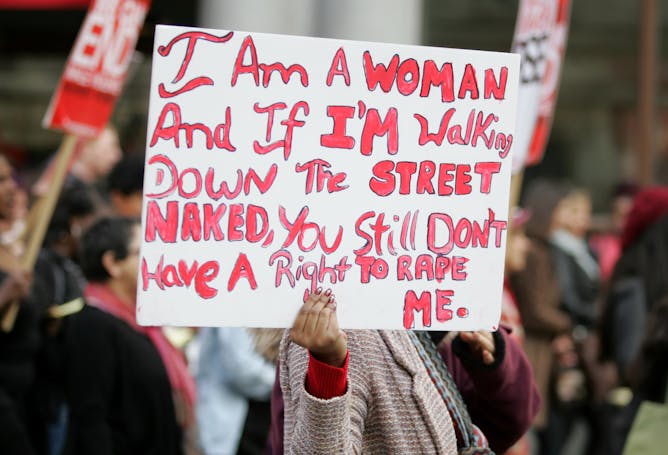In contemporary discourse, the intricate relationship between feminism and societal perceptions of gendered violence against men has ignited fervent debates. The notion that feminism is culpable for crimes against men encapsulates a broader social phenomenon, where prevailing gender norms and power dynamics are scrutinized. This discussion seeks to unpack the complexities surrounding this controversy, elucidating the historical roots of these perceptions, the dichotomies within feminist thought, and the implications of attributing blame to a movement advocating for equality.
The historical evolution of feminism heralds a paradigm shift in gender relations. Dominant patriarchal structures have historically marginalized women’s voices, legitimizing misogyny and reinforcing violence against women. Feminism emerged as a response to these injustices, advocating for women’s rights, gender equity, and the dismantling of systemic oppression. In exploring why feminism has come to be blamed for crimes against men, it is imperative to understand the historical context in which these narratives have developed.
One cannot overlook the fact that the emergence of feminism coincided with a challenge to traditional masculinity frameworks. The ideological battle for women’s rights often catalyzed defensive reactions from certain segments of the male populace, engendering a perception that such movements threaten their societal standing. This defensive posture is part of a broader cultural backlash against progress—distilling the movement’s legitimate grievances into a fabricated guilt that ensnares all feminists as antagonists against men.
Subsequently, this perceived antagonism has been exacerbated by media narratives that sensationalize instances of male victimization while undermining the gravity of female victimization. Within these narratives, the concept of ‘male privilege’ is often weaponized, portraying men as oppressive agents within a feminist discourse obsessed solely with female suffering. Such simplifications fail to recognize the multifaceted nature of gender relations, whereby toxic masculinity serves to perpetuate harm against both genders. When men articulate their experiences of victimization, the discourse frequently collapses into a reductive narrative that invalidates their claims in the face of feminist advocacy.
Delving deeper into the anxieties surrounding this perceived threat reveals an entrenched fear of emasculation within certain societal sectors. This fear is often rooted in hypermasculine ideals that equate strength with dominance, and vulnerability with failure. Consequently, when feminism advocates for a reimagining of gender roles that emphasizes emotional expressiveness and equality, it inadvertently provokes a defensive posture among those who identify with traditional masculinity. This dynamic further contributes to the notion that the feminist movement is, at its core, a catalyst for crimes against men—a belied claim that overlooks the complexities of contemporary gender relations.
Moreover, it is essential to highlight the splintered factions within feminist thought that have contributed to the confusion surrounding the movement’s relationship with men. Different strands of feminism—radical, liberal, and intersectional—offer disparate views regarding male accountability and the systemic nature of gender-based violence. While some feminists aptly criticize patriarchy for its deleterious effects, others advocate for a more conciliatory approach that seeks collaborative solutions across genders. This multifaceted landscape complicates the narrative of a united feminist front that is uniformly antagonistic toward men.
Recognizing that some narratives suggest men as victims of female-perpetrated crimes invites a critique of the systems that shape these negative portrayals. Notably, when male victims of violence do not receive adequate support or recognition, it often results in a societal perspective that positions feminism as an adversary rather than an ally in addressing violence and suffering across the gender spectrum. This is further compounded by the statistical underreporting of male victimization, rendering their experiences less visible and often leading to the erroneous conclusion that men’s issues receive inadequate attention.
The responses to these assertions have birthed a counter-argument that seeks to delineate the vital distinction between advocating for women’s rights and fostering an environment where men’s experiences are minimized. A constructive dialogue emphasizes the necessity of inclusive discussions that recognize the nuanced realities of both genders. By positioning oneself within the feminist narrative, it is possible to advocate for the rights of all individuals—men included—against the backdrop of established systemic gender biases.
In order to dismantle the blame placed upon feminism for crimes against men, it is critical to establish a framework that prioritizes empathy over antagonism. The dialogue has often devolved into polarization, with each side hesitating to engage with the complexities of the other’s plight. By fostering spaces for open discussion about the vulnerabilities faced by men—be it in the context of domestic violence, mental health crises, or societal expectations—feminism can evolve into a movement that embodies egalitarian principles while addressing the multifarious concerns of all genders.
Moreover, examining the societal structures that perpetuate violence against individuals—regardless of gender—necessitates a collective effort. Understanding the intersectionality of race, class, and gender allows for a broader examination of societal violence, fostering a narrative that transcends victimhood. It is paramount to recognize that feminist activism can advance the cause for men without sacrificing the foundational pursuits of women’s rights as fundamental human rights.
Importantly, this reflections on feminism’s alleged blame for crimes against men invites a collective re-examination of how society articulates gender issues. A more nuanced understanding of the dynamics at play may serve to alleviate tensions between feminist advocates and those who perceive their movement as hostile. Through education and reframing narratives surrounding masculinity, it becomes possible to cultivate an inclusive dialogue that seeks resolution rather than conflict.
Ultimately, the critique of feminism as the scapegoat for crimes against men underscores a societal discomfort with addressing the complexities of gender relations. Rather than viewing feminism as a divisive force, it is prudent to embrace its core tenets of equality, inclusiveness, and advocacy for the marginalized. In embracing these principles, society can foster an environment wherein discussions surrounding victimhood reflect the realities of all individuals, empowering a collective movement toward a more equitable future.





























